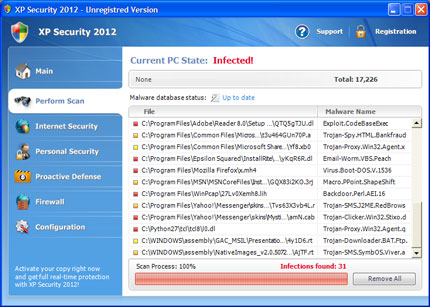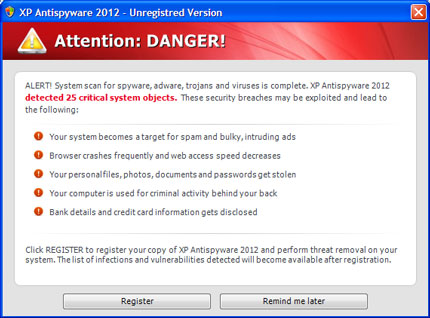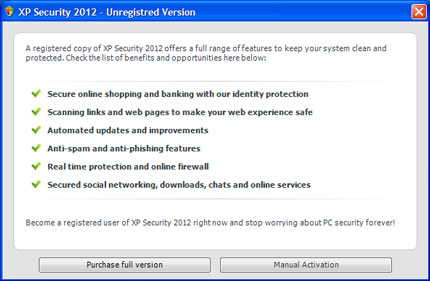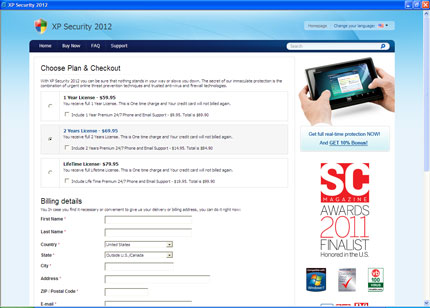TROJ_FAKEAV.DZY
Trojan.Win32.FakeAV.ecva (Kaspersky); Generic FakeAlert!qx (McAfee); Rogue:Win32/FakeRean (Microsoft)
Windows 2000, Windows XP, Windows Server 2003


Threat Type: Trojan
Destructiveness: No
Encrypted: No
In the wild: Yes
OVERVIEW
This Trojan arrives on a system as a file dropped by other malware or as a file downloaded unknowingly by users when visiting malicious sites. It may be downloaded by other malware/grayware/spyware from remote sites.
It employs registry shell spawning by adding certain registry entries. This allows this malware to execute even when other applications are opened.
It modifies certain registry entries to disable Security Center functions. Doing this allows this malware to execute its routines without being detected. It bypasses the Windows firewall. This allows the malware to perform its intended routine without being detected by an installed firewall.
It steals certain information from the system and/or the user.
It deletes the initially executed copy of itself.
It displays fake alerts that warn users of infection. It also displays fake scanning results of the affected system. It then asks for users to purchase it once scanning is completed. If users decide to purchase the rogue product, users are directed to a certain website asking for sensitive information, such as credit card numbers.
TECHNICAL DETAILS
Arrival Details
This Trojan arrives on a system as a file dropped by other malware or as a file downloaded unknowingly by users when visiting malicious sites.
It may be downloaded by other malware/grayware/spyware from remote sites.
Installation
This Trojan drops the following copies of itself into the affected system:
- %Application Data%\{random filename}.exe
(Note: %Application Data% is the current user's Application Data folder, which is usually C:\Windows\Profiles\{user name}\Application Data on Windows 98 and ME, C:\WINNT\Profiles\{user name}\Application Data on Windows NT, and C:\Documents and Settings\{user name}\Local Settings\Application Data on Windows 2000, XP, and Server 2003.)
It drops the following non-malicious files:
- %System Root%\Documents and Settings\All Users\Application Data\{random file name}
- %Application Data%\{random file name}
- %User Temp%\{random file name}
- %User Profile%\Templates\{random file name}
- %Application Data%\GDIPFONTCACHEV1.DAT - a non malicious file used by Microsoft Windows as a cache for storing font data
(Note: %System Root% is the root folder, which is usually C:\. It is also where the operating system is located.. %Application Data% is the current user's Application Data folder, which is usually C:\Windows\Profiles\{user name}\Application Data on Windows 98 and ME, C:\WINNT\Profiles\{user name}\Application Data on Windows NT, and C:\Documents and Settings\{user name}\Local Settings\Application Data on Windows 2000, XP, and Server 2003.. %User Temp% is the current user's Temp folder, which is usually C:\Documents and Settings\{user name}\Local Settings\Temp on Windows 2000, XP, and Server 2003.. %User Profile% is the current user's profile folder, which is usually C:\Windows\Profiles\{user name} on Windows 98 and ME, C:\WINNT\Profiles\{user name} on Windows NT, and C:\Documents and Settings\{user name} on Windows 2000, XP, and Server 2003.)
It adds the following mutexes to ensure that only one of its copies runs at any one time:
- ir4cnxm3oi333
- {C9A34C77-4D69-45EC-A07D-83242376045D}
Autostart Technique
This Trojan adds the following registry entries to enable its automatic execution at every system startup:
HKEY_CURRENT_USER\Software\Microsoft\
Windows\CurrentVersion\Run
{random numbers} = %Application Data%\{random filename}.exe
It employs registry shell spawning to ensure its execution when certain file types are accessed by adding the following entries:
HKEY_CLASSES_ROOT\.exe\shell\
open\command
@ = ""%Application Data%\{random filename}.exe" -a "%1" %*"
HKEY_CURRENT_USER\Software\Classes\
.exe\shell\open\
command
@ = ""%Application Data%\{random filename}.exe" -a "%1" %*"
HKEY_CURRENT_USER\Software\Classes\
exefile\shell\open\
command
@ = ""%Application Data%\{random filename}.exe" -a "%1" %*"
HKEY_CLASSES_ROOT\exefile\shell\
open\command
{default} = ""%Application Data%\{random filename}.exe" -a "%1" %*"
Other System Modifications
This Trojan modifies the following registry key(s)/entry(ies) as part of its installation routine:
HKEY_CLASSES_ROOT\exefile\shell\
open\command
{default} = ""%Application Data%\{random filename}.exe" -a "%1" %*"
(Note: The default value data of the said registry entry is {default} ""%1" %*" .)
HKEY_LOCAL_MACHINE\SOFTWARE\Clients\
StartMenuInternet\FIREFOX.EXE\shell\
open\command
{default} = ""%Application Data%\{random filename}.exe" -a "%Program Files%\Mozilla Firefox\firefox.exe""
(Note: The default value data of the said registry entry is "%Program Files%\Mozilla Firefox\firefox.exe".)
HKEY_LOCAL_MACHINE\SOFTWARE\Clients\
StartMenuInternet\FIREFOX.EXE\shell\
safemode\command
{default} = ""%Application Data%\{random filename}.exe" -a "%Program Files%\Mozilla Firefox\firefox.exe" -safe-mode"
(Note: The default value data of the said registry entry is ""%Program Files%\Mozilla Firefox\firefox.exe" -safe-mode".)
HKEY_LOCAL_MACHINE\SOFTWARE\Clients\
StartMenuInternet\IEXPLORE.EXE\shell\
open\command
{default} = ""%Application Data%\{random filename}.exe" -a "%Program Files%\Internet Explorer\iexplore.exe""
(Note: The default value data of the said registry entry is ""%Program Files%\Internet Explorer\iexplore.exe"".)
It modifies the following registry entries to disable Security Center functions:
HKEY_LOCAL_MACHINE\SOFTWARE\Microsoft\
Security Center
AntiVirusDisableNotify = 1
(Note: The default value data of the said registry entry is 0.)
HKEY_LOCAL_MACHINE\SOFTWARE\Microsoft\
Security Center
FirewallDisableNotify = 1
(Note: The default value data of the said registry entry is 0.)
HKEY_LOCAL_MACHINE\SOFTWARE\Microsoft\
Security Center
UpdatesDisableNotify = 1
(Note: The default value data of the said registry entry is 0.)
HKEY_LOCAL_MACHINE\SOFTWARE\Microsoft\
Security Center
AntiVirusOverride = 1
(Note: The default value data of the said registry entry is 0.)
HKEY_LOCAL_MACHINE\SOFTWARE\Microsoft\
Security Center
FirewallOverride = 1
(Note: The default value data of the said registry entry is 0.)
It modifies the following registry entries to disable the Windows Firewall settings:
HKEY_LOCAL_MACHINE\SYSTEM\CurrentControlSet\
Services\SharedAccess\Parameters\
FirewallPolicy\StandardProfile
EnableFirewall = 0
(Note: The default value data of the said registry entry is 1.)
HKEY_LOCAL_MACHINE\SYSTEM\CurrentControlSet\
Services\SharedAccess\Parameters\
FirewallPolicy\StandardProfile
DisableNotifications = 1
(Note: The default value data of the said registry entry is 0.)
It creates the following registry entry(ies) to bypass Windows Firewall:
HKEY_LOCAL_MACHINE\SYSTEM\CurrentControlSet\
Services\SharedAccess\Parameters\
FirewallPolicy\DomainProfile
EnableFirewall = "0"
HKEY_LOCAL_MACHINE\SYSTEM\CurrentControlSet\
Services\SharedAccess\Parameters\
FirewallPolicy\DomainProfile
DoNotAllowExceptions = "0"
HKEY_LOCAL_MACHINE\SYSTEM\CurrentControlSet\
Services\SharedAccess\Parameters\
FirewallPolicy\DomainProfile
DisableNotifications = "1"
HKEY_LOCAL_MACHINE\SYSTEM\CurrentControlSet\
Services\SharedAccess\Parameters\
FirewallPolicy\StandardProfile
EnableFirewall = "0"
HKEY_LOCAL_MACHINE\SYSTEM\CurrentControlSet\
Services\SharedAccess\Parameters\
FirewallPolicy\StandardProfile
DoNotAllowExceptions = "0"
HKEY_LOCAL_MACHINE\SYSTEM\CurrentControlSet\
Services\SharedAccess\Parameters\
FirewallPolicy\StandardProfile
DisableNotifications = "1"
Information Theft
This Trojan steals the following information:
- Credit card information (i.e. card type, card number, expiration date, security code)
- Contact information (i.e. name, address, email, phone number)
Other Details
This Trojan deletes the initially executed copy of itself
Rogue Antivirus Routine
This Trojan displays fake alerts that warn users of infection. It also displays fake scanning results of the affected system. It then asks for users to purchase it once scanning is completed. If users decide to purchase the rogue product, users are directed to a certain website asking for sensitive information, such as credit card numbers.
NOTES:
It installs itself on the infected system as a rogue antivirus using the following names:
- {OS Name} Security 2012
- {BLOCKED}rijugeg.com
- {BLOCKED}cuqekexo.com
- {BLOCKED}iri.com
- {BLOCKED}cufinulo.com
- {BLOCKED}igj.com
- {BLOCKED}gymeb.com
- {BLOCKED}wupode.com
- {BLOCKED}powq.com
- {BLOCKED}cet.com
- {BLOCKED}xiru.com
- {BLOCKED}heduf.com
- {BLOCKED}fisnu.com
- {BLOCKED}ezociw.com
- {BLOCKED}hup.com
- {BLOCKED}yxr.com
- {BLOCKED}hywe.com
- {BLOCKED}bru.com
- {BLOCKED}cyvzym.com
- {BLOCKED}elw.com
- {BLOCKED}reme.com
- {BLOCKED}ilugoq.com
- {BLOCKED}bq.com
- {BLOCKED}lurypugi.com
- {BLOCKED}qel.com
- {BLOCKED}kenuqi.com
- {BLOCKED}tuk.com
- {BLOCKED}ohuli.com
- {BLOCKED}iwo.com
- {BLOCKED}owu.com
- {BLOCKED}uryp.com
- {BLOCKED}odojyx.com
SOLUTION
Step 1
For Windows XP and Windows Server 2003 users, before doing any scans, please make sure you disable System Restore to allow full scanning of your computer.
Step 2
Identify and terminate files detected as TROJ_FAKEAV.DZY
- If the detected file is displayed in either Windows Task Manager or Process Explorer but you cannot delete it, restart your computer in safe mode. To do this, refer to this link for the complete steps.
- If the detected file is not displayed in either Windows Task Manager or Process Explorer, continue doing the next steps.
Step 3
Delete this registry value
Important: Editing the Windows Registry incorrectly can lead to irreversible system malfunction. Please do this step only if you know how or you can ask assistance from your system administrator. Else, check this Microsoft article first before modifying your computer's registry.
- In HKEY_CURRENT_USER\Software\Microsoft\Windows\CurrentVersion\Run
- (random numbers} = %Application Data%\{random filename}.exe
- In HKEY_CLASSES_ROOT\.exe\shell\open\command
- {default} = %Application Data%\{random filename}.exe -a %1 %*
- In HKEY_CLASSES_ROOT\exefile\shell\open\command
- {default} = %Application Data%\{random filename}.exe -a %1 %*
- In HKEY_CURRENT_USER\Software\Classes\.exe\shell\open\command
- {default} = %Application Data%\{random filename}.exe -a %1 %*
- In HKEY_CURRENT_USER\Software\Classes\exefile\shell\open\command
- {default} = %Application Data%\{random filename}.exe -a %1 %*
- In HKEY_LOCAL_MACHINE\SYSTEM\CurrentControlSet\Services\SharedAccess
\Parameters\FirewallPolicy\ - DomainProfileEnableFirewall = 0
- In HKEY_LOCAL_MACHINE\SYSTEM\CurrentControlSet\Services\SharedAccess
\Parameters\FirewallPolicy\ - DomainProfileDoNotAllowExceptions = 0
- In HKEY_LOCAL_MACHINE\SYSTEM\CurrentControlSet\Services\SharedAccess
\Parameters\FirewallPolicy\ - DomainProfileDisableNotifications = 1
- In HKEY_LOCAL_MACHINE\SYSTEM\CurrentControlSet\Services\SharedAccess
\Parameters\FirewallPolicy\ - StandardProfileEnableFirewall = 0
- In HKEY_LOCAL_MACHINE\SYSTEM\CurrentControlSet\Services\SharedAccess
\Parameters\FirewallPolicy\ - StandardProfileDoNotAllowExceptions = 0
- In HKEY_LOCAL_MACHINE\SYSTEM\CurrentControlSet\Services\SharedAccess
\Parameters\FirewallPolicy\ - StandardProfileDisableNotifications = 1
Step 4
Restore this modified registry value
Important: Editing the Windows Registry incorrectly can lead to irreversible system malfunction. Please do this step only if you know how or you can ask assistance from your system administrator. Else, check this Microsoft article first before modifying your computer's registry.
- In HKEY_CLASSES_ROOT\exefile\shell\open\command
- From: {default} = %Application Data%\{random filename}.exe -a %1 %*
- To: {default} = {default}%1 %*
- In HKEY_LOCAL_MACHINE\SOFTWARE\Clients\StartMenuInternet\FIREFOX.EXE\shell\open\command
- From: {default} = %Application Data%\{random filename}.exe -a %Program Files%\Mozilla Firefox\firefox.exe
- To: {default} = %Program Files%\Mozilla Firefox\firefox.exe
- In HKEY_LOCAL_MACHINE\SOFTWARE\Clients\StartMenuInternet\FIREFOX.EXE\shell\safemode\command
- From: {default} = %Application Data%\{random filename}.exe -a %Program Files%\Mozilla Firefox\firefox.exe -safe-mode
- To: {default} = %Program Files%\Mozilla Firefox\firefox.exe -safe-mode
- In HKEY_LOCAL_MACHINE\SOFTWARE\Clients\StartMenuInternet\IEXPLORE.EXE\shell\open\command
- From: {default} = %Application Data%\{random filename}.exe -a %Program Files%\Internet Explorer\iexplore.exe
- To: {default} = %Program Files%\Internet Explorer\iexplore.exe
- In HKEY_LOCAL_MACHINE\SOFTWARE\Microsoft\Security Center
- From: AntiVirusDisableNotify = 1
- To: AntiVirusDisableNotify = 0
- In HKEY_LOCAL_MACHINE\SOFTWARE\Microsoft\Security Center
- From: FirewallDisableNotify = 1
- To: FirewallDisableNotify = 0
- In HKEY_LOCAL_MACHINE\SOFTWARE\Microsoft\Security Center
- From: UpdatesDisableNotify = 1
- To: UpdatesDisableNotify = 0
- In HKEY_LOCAL_MACHINE\SOFTWARE\Microsoft\Security Center
- From: AntiVirusOverride = 1
- To: AntiVirusOverride = 0
- In HKEY_LOCAL_MACHINE\SOFTWARE\Microsoft\Security Center
- From: FirewallOverride = 1
- To: FirewallOverride = 0
- InHKEY_LOCAL_MACHINE\SYSTEM\CurrentControlSet\Services\SharedAccess\Parameters\FirewallPolicy\StandardProfile
- From: EnableFirewall = 0
- To: EnableFirewall = 1
- In HKEY_LOCAL_MACHINE\SYSTEM\CurrentControlSet\Services\SharedAccess\Parameters\FirewallPolicy\StandardProfile
- From: DisableNotifications = 1
- To: DisableNotifications = 0
Step 5
Search and delete these files
- %System Root%\Documents and Settings\All Users\Application Data\{random file name}
- %Application Data%\{random file name}
- %User Temp%\{random file name}
- %User Profile%\Templates\{random file name}
- %Application Data%\GDIPFONTCACHEV1.DAT
Step 6
Scan your computer with your Trend Micro product to delete files detected as TROJ_FAKEAV.DZY. If the detected files have already been cleaned, deleted, or quarantined by your Trend Micro product, no further step is required. You may opt to simply delete the quarantined files. Please check this Knowledge Base page for more information.
Did this description help? Tell us how we did.





